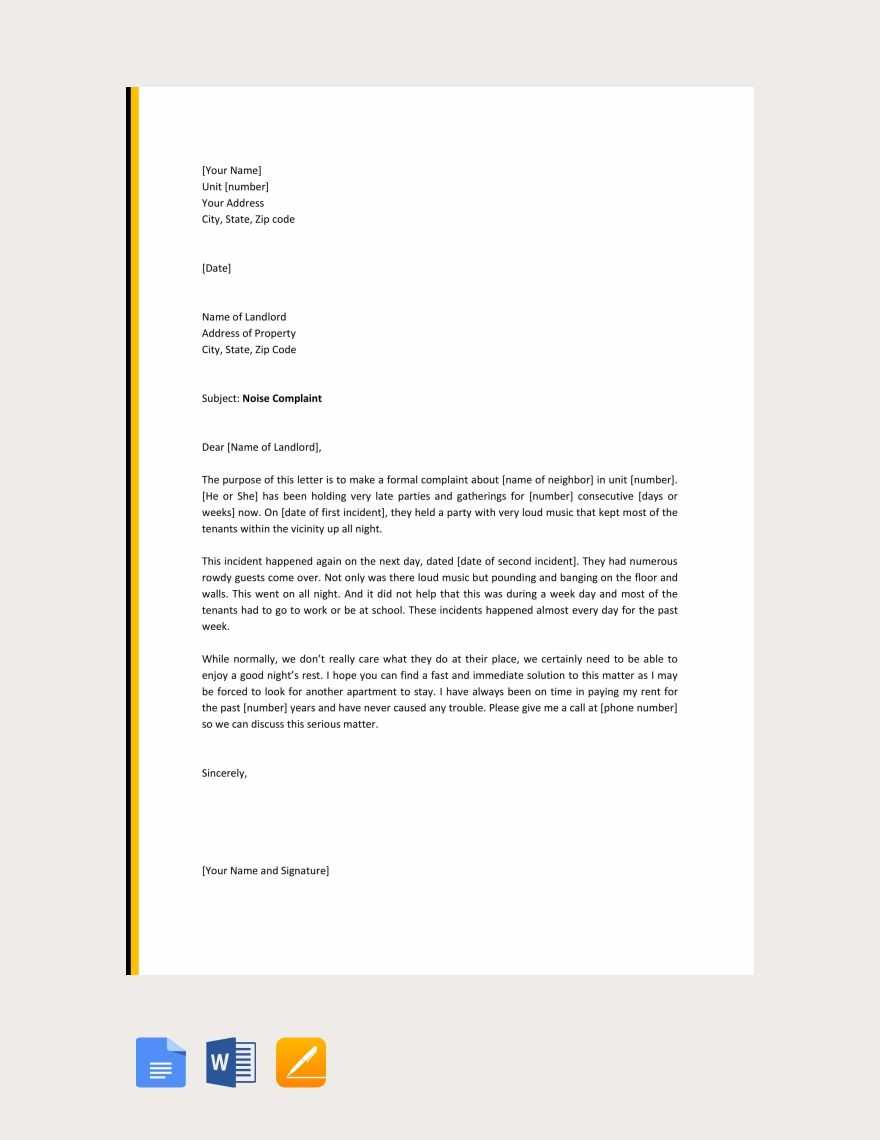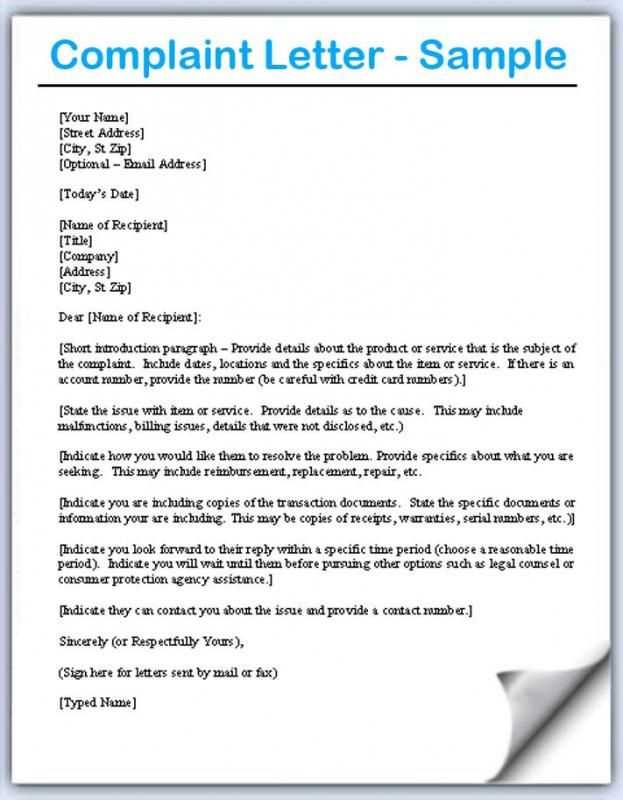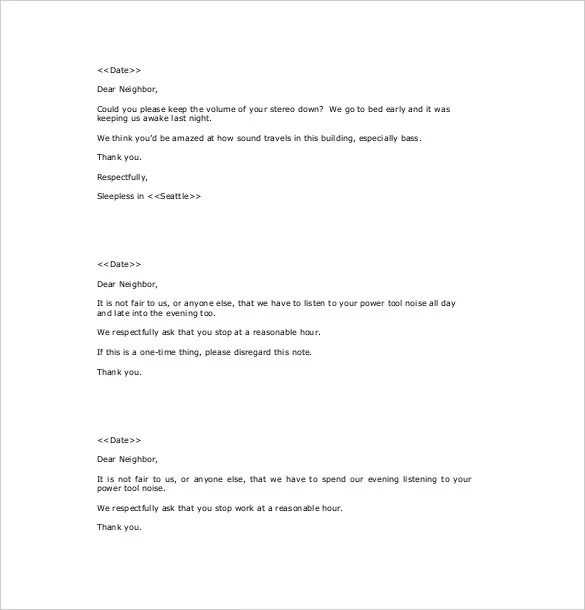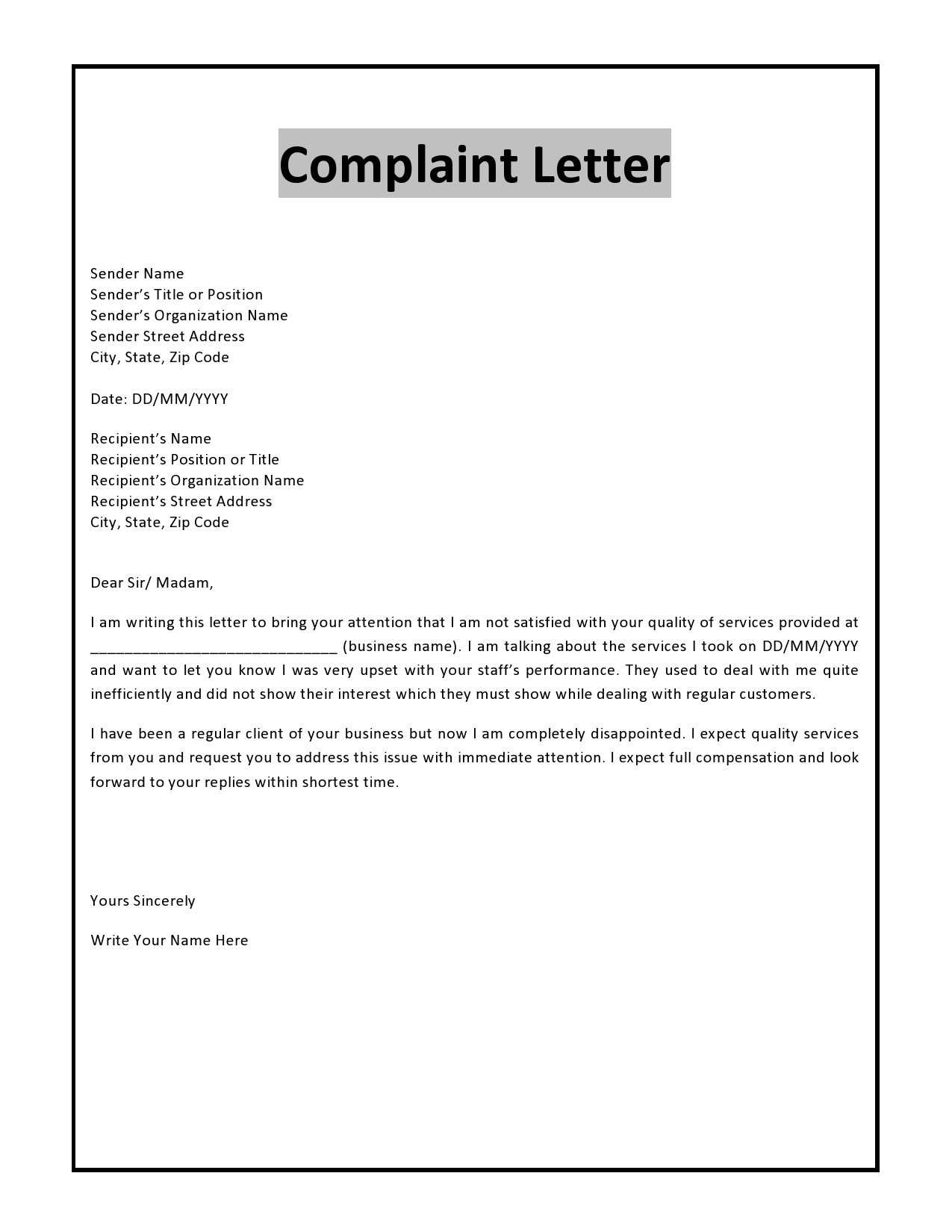Noise Complaint Letter Template for Effective Communication

When disturbances from neighboring spaces become unbearable, it’s important to address the issue calmly and professionally. Expressing concerns in writing can often be more effective than verbal communication, especially in sensitive situations. A well-crafted message allows you to present your case clearly and with the right level of formality, making it easier for the recipient to understand your discomfort.
Crafting a clear and concise message is essential when trying to resolve such matters. You should highlight the problem while maintaining a respectful tone. Providing specific details about the disturbances can help the recipient understand the severity of the issue, making it more likely they will take the necessary actions to rectify it.
While addressing disruptive sounds, it’s important to remain constructive. Focus on creating a solution-oriented approach, rather than just listing grievances. This helps maintain good relationships while ensuring your concerns are heard and acted upon.
How to Write a Noise Complaint Letter
When dealing with unwanted disturbances in your environment, it’s essential to address the issue formally and respectfully. Writing a well-structured message can help convey your concerns effectively while maintaining a calm and polite tone. A well-crafted approach increases the chances of a positive resolution to the problem.
Be clear and specific when describing the issue. Provide relevant details such as the time, frequency, and nature of the disturbance. This will allow the recipient to understand the context and severity of the situation. Make sure to stay objective and avoid emotional language that could escalate the situation.
Additionally, it’s important to suggest a possible solution or request specific actions. Whether it’s a request for quieter hours or an appeal for intervention from authorities, your letter should guide the reader toward a resolution that is both reasonable and fair. Keeping the tone polite but firm will help ensure that your concerns are taken seriously.
Key Elements to Include in Your Letter
When expressing your concerns about disturbances, it’s important to include certain details that will make your message clear and actionable. A well-structured communication should cover the key aspects of the issue while maintaining a respectful tone. The right approach can help ensure that your message is taken seriously and leads to a resolution.
Start by providing specific information about the disruption. Mention the exact times and dates when the disturbance occurred to give a clear picture of the situation. If possible, describe the nature of the disturbance in a way that helps the recipient understand its impact.
Additionally, it’s helpful to include your contact information and any other relevant details, such as the location or people involved. This makes it easier for the recipient to follow up with you. Be sure to conclude your communication with a request for resolution or suggested next steps, keeping the tone constructive.
Effective Tone for Addressing Noise Issues

When addressing disturbances, the tone of your message plays a critical role in ensuring that your concerns are heard and respected. A well-chosen tone can encourage cooperation, while an overly harsh or emotional tone may lead to defensiveness or conflict. It is essential to find a balance between expressing your discomfort and maintaining a respectful approach.
Striking the Right Balance
Ensure that your message is firm yet courteous. Start by stating the problem clearly but avoid sounding accusatory. Focus on how the issue affects you rather than blaming others, as this can help foster a more positive and productive dialogue.
Maintaining Professionalism
Even if the situation is frustrating, try to remain professional. Keep your language polite and constructive, aiming for a resolution rather than escalating the conflict. Offering a solution or making a reasonable request demonstrates a willingness to work together to resolve the issue.
| Appropriate Tone | Inappropriate Tone |
|---|---|
| Calm and respectful | Hostile or aggressive |
| Clear and direct | Overly emotional |
| Solution-oriented | Blaming or accusatory |
Common Mistakes to Avoid in Complaints
When addressing disturbances or issues, certain missteps can undermine the effectiveness of your message. Making mistakes in how you present your concerns can lead to misunderstandings or hinder the possibility of a quick resolution. It’s crucial to be mindful of these common errors to ensure your communication is received positively and acted upon appropriately.
Being Too Vague

A common mistake is not providing enough detail about the situation. If your message lacks specifics, the recipient may not fully understand the extent or frequency of the problem. Be clear and provide concrete examples of when and how the disturbance occurs, making it easier for the recipient to assess and address the issue.
Using an Aggressive Tone
While it’s understandable to feel frustrated, using harsh or confrontational language can escalate the situation. Instead of demanding or blaming, try to keep your message polite and solution-focused. Approach the situation with respect to encourage a more cooperative response.
How to Customize Your Template

When using a pre-written structure for addressing disturbances, it’s important to tailor the content to your specific situation. Customizing your message ensures that it accurately reflects the details of your case and resonates with the recipient. By personalizing the communication, you increase the likelihood of a timely and appropriate response.
Begin by adjusting the basic details, such as the dates, times, and nature of the disturbance. Specific information will make your message more relevant and credible. Additionally, replace any generic phrasing with language that fits your particular experience, ensuring the communication feels genuine.
Also, consider including any relevant requests or solutions that can help resolve the issue. Whether you want a follow-up action or just a change in behavior, stating your expectations clearly will guide the recipient toward an effective response.
Sending Your Noise Complaint Properly
Once you’ve crafted your message, sending it effectively is just as important as the content itself. Proper delivery ensures that your concerns are taken seriously and can help facilitate a swift resolution. Choosing the right method and timing can make all the difference in how your message is received.
Choosing the Right Method
There are several ways to send your message, including email, physical mail, or even in person. Consider the preferred communication method of the recipient. If you’re sending your message via email, ensure that it’s clearly written and free from any mistakes. If using physical mail, ensure it’s properly addressed and sent via a reliable service.
Timing and Follow-Up
Sending your message at an appropriate time can increase the chances of a prompt response. Avoid sending it during holidays or busy periods when it may be overlooked. Additionally, keep track of when you send your communication and follow up if you do not receive a response within a reasonable time frame.
What to Do After Sending the Letter
After you’ve sent your message addressing the issue, it’s important to follow up and monitor the situation. Taking the right steps after sending your communication ensures that your concerns are acknowledged and acted upon appropriately.
- Wait for a Response: Give the recipient some time to process your message. Typically, allowing a week or two for a response is reasonable.
- Monitor the Situation: Keep track of any changes or improvements regarding the disturbance. This will help you determine if further action is necessary.
- Be Prepared to Follow Up: If you don’t hear back in a timely manner, prepare to follow up with a polite reminder. You can either resend your message or reach out by phone or in person.
If the situation doesn’t improve, consider escalating the issue to a higher authority or seeking mediation. Staying calm and professional throughout the process will increase the chances of a successful resolution.